Java JDBC
jdbc概述
基本介绍
1.JDBC为访问不同的数据库提供了统一的接口,为使用者屏蔽了细节问题。
2.Java程序员使用JDBC,可以连接任何提供了JDBC驱动程序的数据库系统,从而完成对数据库的各种操作。
jdbc原理示意图


jdbc快速入门
JDBC程序编写步骤
1.注册驱动 - 加载Driver类
2.获取连接 - 得到Connection
3.执行增删改查 - 发送SQL给mysql执行
4.释放资源 - 关闭相关连接
import com.mysql.jdbc.Driver;
import java.sql.Connection;
import java.sql.SQLException;
import java.sql.Statement;
import java.util.Properties;
public class Jdbc01 {
public static void main(String[] args) throws SQLException {
// 注册驱动 - 加载Driver类
Driver driver = new Driver();
String url = "jdbc:mysql://localhost:3306/hsp_db02";
Properties properties = new Properties();
properties.setProperty("user", "root");
properties.setProperty("password", "hsp");
String sql = "insert into actor values(null,'刘德华','男','1970-11-11', '110')";
// 获取连接 - 得到Connection
Connection connection = driver.connect(url, properties);
// statement 用于执行静态SQL语句并返回其生成的结果的对象
Statement statement = connection.createStatement();
int rows = statement.executeUpdate(sql);
System.out.println(rows > 0 ? "成功" : "失败");
// 关闭连接资源
statement.close();
connection.close();
}
}
获取数据库连接5种方式

方式1 com.hspedu.jdbc.conn
会直接使用com.mysql.jdbc.Driver(),属于静态加载,灵活性差,依赖强
public void connect01() throws SQLException {
Driver driver = new Driver();
String url = "jdbc:mysql://localhost:3306/hsp_db02";
Properties properties = new Properties();
properties.setProperty("user", "root");
properties.setProperty("password", "hsp");
String sql = "insert into actor values(null,'刘德华','男','1970-11-11', '110')";
Connection connection = driver.connect(url, properties);
Statement statement = connection.createStatement();
int rows = statement.executeUpdate(sql);
System.out.println(rows > 0 ? "成功" : "失败");
statement.close();
connection.close();
}
方式2
便用反射加载Driver类,动态加载,更加时灵活,减少依颗性
@Test
public void connect02() throws ClassNotFoundException, InstantiationException, IllegalAccessException, SQLException {
Class<?> aClass = Class.forName("com.mysql.jdbc.Driver");
Driver driver = (Driver)aClass.newInstance();
String url = "jdbc:mysql://localhost:3306/hsp_db02";
Properties properties = new Properties();
properties.setProperty("user", "root");
properties.setProperty("password", "hsp");
Connection connection = driver.connect(url, properties);
System.out.println(connection);
}
方式3
使用DriverManager 替代 Diver 进行统一管理
@Test
public void connect03() throws ClassNotFoundException, InstantiationException, IllegalAccessException, SQLException {
Class<?> aClass = Class.forName("com.mysql.jdbc.Driver");
Driver driver = (Driver)aClass.newInstance();
String url = "jdbc:mysql://localhost:3306/hsp_db02";
Properties properties = new Properties();
properties.setProperty("user", "root");
properties.setProperty("password", "hsp");
DriverManager.registerDriver(driver);
Connection connection = DriverManager.getConnection(url, properties);
System.out.println(connection);
}
方式4
使用Class.forName自动完成注册驱动,简化代码
@Test
public void connect04() throws ClassNotFoundException, SQLException {
Class.forName("com.mysql.jdbc.Driver");
String url = "jdbc:mysql://localhost:3306/hsp_db02";
Properties properties = new Properties();
properties.setProperty("user", "root");
properties.setProperty("password", "hsp");
Connection connection = DriverManager.getConnection(url, properties);
System.out.println(connection);
}

方式5
方式5,在方式4的基础上改进,增加配置文件,让连接mysql更灵活
@Test
public void connect05() throws ClassNotFoundException, InstantiationException, IllegalAccessException, SQLException, IOException {
Properties properties = new Properties();
properties.load(new FileInputStream("src\\mysql.properties"));
Class.forName(properties.getProperty("driver"));
Connection connection = DriverManager.getConnection(
properties.getProperty("url"),
properties.getProperty("user"),
properties.getProperty("password")
);
System.out.println(connection);
}
ResultSet[结果集]
1.表示数据库结果集的数据表,通常通过执行查询数据库的语句生成
2.ResultSet对象保持一个光标指向其当前的数据行。最初,光标位于第一行之前
3.next方法将光标移动到下一行,并且由于在ResultSeti对象中没有更多行时返回
false,因此可以在while循环中使用循环来遍历结果集


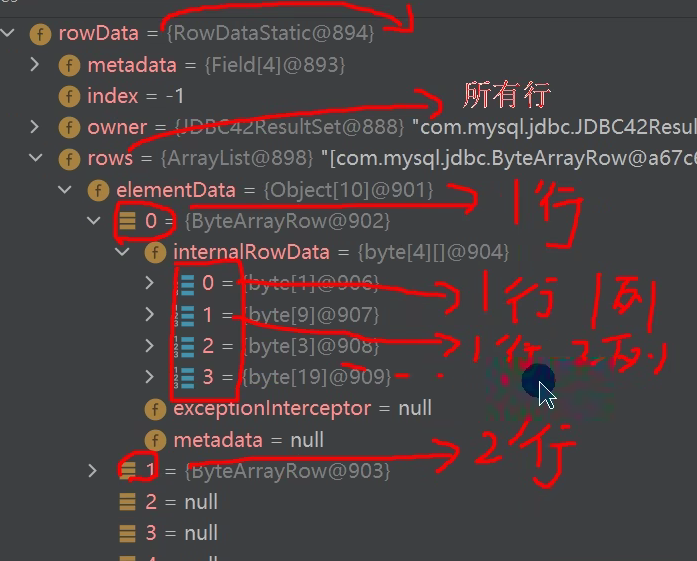
SQL注入
Statement

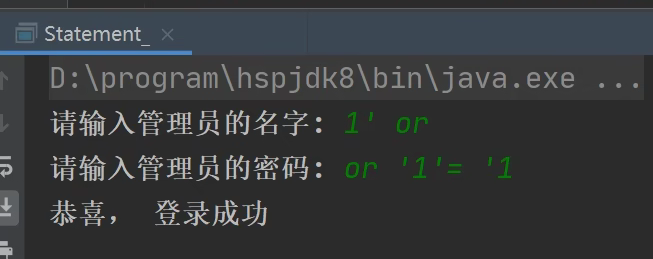
PreparedStatement
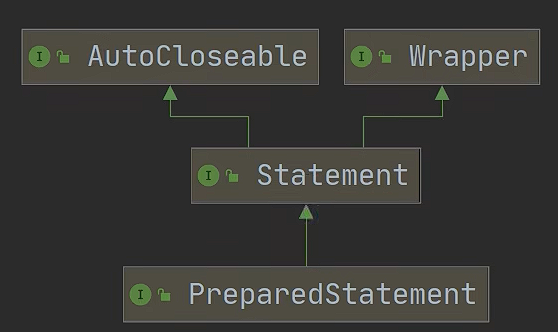
预处理好处
1.不再使用+拼接sql语句,减少语法错误
2.有效的解决了sql注入问题!
3.大大减少了编译次数,效率较高
基本使用


JDBC API



JDBCUtils
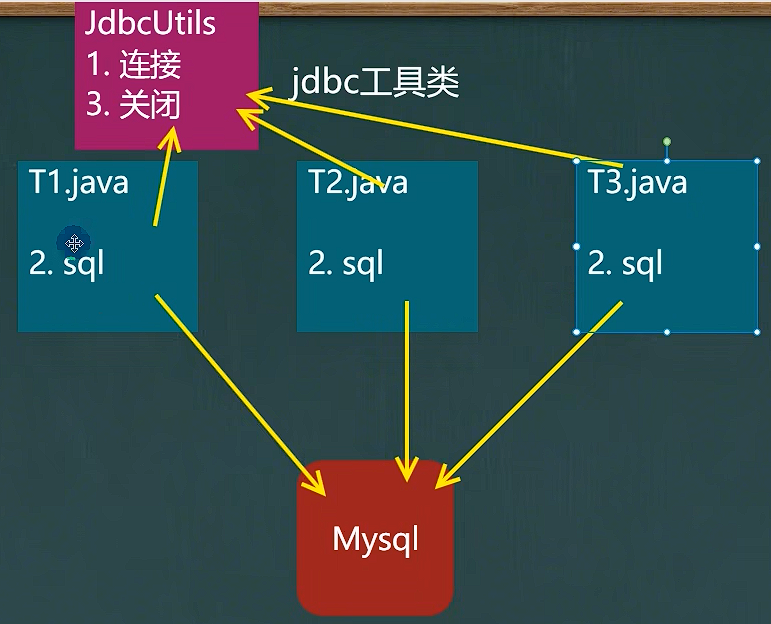
工具类
package com.hspedu.jdbc.utils;
import java.io.FileInputStream;
import java.io.IOException;
import java.sql.*;
import java.util.Properties;
/**
* @program: chapter25
* @since: jdk1.8
* @description: 这是一个工具类,完成mysql的连接和关闭资源
* @author: Administrator
* @create: 2024-12-13 16:54
**/
public class JDBCUtils {
//定义相关属性(4个),因为只需要一份,因此,我们做出static
private static String user;
private static String password;
private static String url;
private static String driver;
// 在静态代码块去初始化
static {
Properties properties = new Properties();
try {
properties.load(new FileInputStream("src\\mysql.properties"));
user = properties.getProperty("user");
password = properties.getProperty("password");
url = properties.getProperty("url");
driver = properties.getProperty("driver");
} catch (IOException e) {
//在实际开发中,我们可以这样处理
//1.将编译异常转成运行异常
//2.这时调用者,可以选择捕获该异常,也可以选择默认处理该异常,比较方便。
throw new RuntimeException(e);
}
}
/**
* 获取数据库连接
*
* @return 返回数据库连接对象
* @throws RuntimeException 如果发生SQL异常,则抛出运行时异常
*/
public static Connection getConnection() {
try {
return DriverManager.getConnection(url, user, password);
} catch (SQLException e) {
throw new RuntimeException(e);
}
}
/**
* 关闭数据库资源
*
* @param rs ResultSet对象,可能为null
* @param stmt Statement对象,可能为null
* @param conn Connection对象,可能为null
* @throws RuntimeException 如果在关闭资源时发生SQL异常,则抛出运行时异常
*/
public static void close(ResultSet rs, Statement stmt, Connection conn) {
try {
if (rs != null) {
rs.close();
}
if (stmt != null) {
stmt.close();
}
if (conn != null) {
conn.close();
}
} catch (SQLException e) {
throw new RuntimeException(e);
}
}
}
使用工具类
package com.hspedu.jdbc.utils;
import org.junit.jupiter.api.Test;
import java.sql.*;
/**
* @program: chapter25
* @since: jdk1.8
* @description: 该类演示如何使用JDBCUtils工具类,完成dml和select
* @author: Administrator
* @create: 2024-12-13 18:00
**/
public class JDBCUtils_Use {
@Test
public void testSelect() {
Connection connection = null;
String sql = "select * from actor where id = ?";
PreparedStatement preparedStatement = null;
ResultSet resultSet = null;
try {
connection = JDBCUtils.getConnection();
preparedStatement = connection.prepareStatement(sql);
preparedStatement.setInt(1, 1);
resultSet = preparedStatement.executeQuery();
while (resultSet.next()) {
int id = resultSet.getInt("id");
String name = resultSet.getString("name");
String sex = resultSet.getString("sex");
Date borndate = resultSet.getDate("borndate");
String phone = resultSet.getString("phone");
System.out.println(id + "\t" + name + "\t" + sex + "\t" + borndate + "\t" + phone);
}
} catch (SQLException e) {
throw new RuntimeException(e);
} finally {
// 关闭资源
JDBCUtils.close(resultSet, preparedStatement, connection);
}
}
@Test
public void testDML() {
Connection connection = null;
String sql = "update actor set name = ? where id = ?";
PreparedStatement preparedStatement = null;
try {
connection = JDBCUtils.getConnection();
preparedStatement = connection.prepareStatement(sql);
preparedStatement.setString(1, "周星驰");
preparedStatement.setInt(2, 1);
int i = preparedStatement.executeUpdate();
System.out.println(i > 0 ? "成功" : "失败");
} catch (SQLException e) {
throw new RuntimeException(e);
} finally {
// 关闭资源
JDBCUtils.close(null, preparedStatement, connection);
}
}
}
事务
基本介绍

应用实例
模拟经典的转帐业务 - 未使用事务

public class Transaction_ {
@Test
public void noTransaction() {
Connection connection = null;
String sql = "update account set balance = balance - 100 where id = 1";
String sql2 = "update account set balance = balance + 100 where id = 2";
PreparedStatement preparedStatement = null;
try {
connection = JDBCUtils.getConnection();
preparedStatement = connection.prepareStatement(sql);
preparedStatement.executeUpdate();
int i = 1 / 0;
preparedStatement = connection.prepareStatement(sql2);
preparedStatement.executeUpdate();
} catch (SQLException e) {
throw new RuntimeException(e);
} finally {
// 关闭资源
JDBCUtils.close(null, preparedStatement, connection);
}
}
}
马云的余额减少了马化腾的余额缺没有增加,银行很开心_
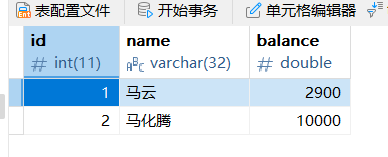
模拟经典的转帐业务 - 使用事务
public void useTransaction() {
Connection connection = null;
String sql = "update account set balance = balance - 100 where id = 1";
String sql2 = "update account set balance = balance + 100 where id = 2";
PreparedStatement preparedStatement = null;
try {
// 默认情况下,connection是默认自动提交
connection = JDBCUtils.getConnection();
// 将 connection 设置为不自动提交
connection.setAutoCommit(false); // 相当于开启了事务
preparedStatement = connection.prepareStatement(sql);
preparedStatement.executeUpdate();
int i = 1 / 0; // 抛出异常
preparedStatement = connection.prepareStatement(sql2);
preparedStatement.executeUpdate();
// 提交事务
connection.commit();
} catch (Exception e) {
System.out.println("执行发生了异常,撤销执行的sql");
try {
// 回滚到事务开启的地方
if (connection != null) {
connection.rollback();
}
} catch (SQLException ex) {
ex.printStackTrace();
}
e.printStackTrace();
} finally {
// 关闭资源
JDBCUtils.close(null, preparedStatement, connection);
}
}


批处理
基本介绍

传统方式
public void noBatch() throws SQLException {
Connection connection = JDBCUtils.getConnection();
String sql = "insert into admin2 values(null, ?, ?)";
PreparedStatement preparedStatement = connection.prepareStatement(sql);
System.out.println("开始执行");
long start = System.currentTimeMillis();
for (int i = 0; i < 5000; i++) {
preparedStatement.setString(1, "jack" + i);
preparedStatement.setString(2, "666");
preparedStatement.executeUpdate();
}
System.out.println("结束执行");
long end = System.currentTimeMillis();
System.out.println("传统的方式 耗时:" + (end - start) + "ms");
JDBCUtils.close(null, preparedStatement, connection);
}
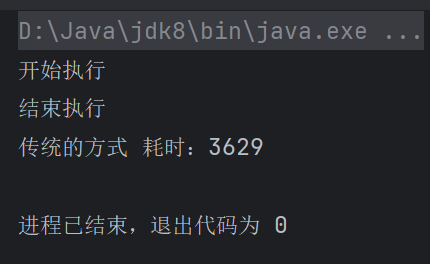
批处理方式
public void batch() throws SQLException {
Connection connection = JDBCUtils.getConnection();
String sql = "insert into admin2 values(null, ?, ?)";
PreparedStatement preparedStatement = connection.prepareStatement(sql);
System.out.println("开始执行");
long start = System.currentTimeMillis();
for (int i = 0; i < 5000; i++) {
preparedStatement.setString(1, "jack" + i);
preparedStatement.setString(2, "666");
preparedStatement.addBatch();
// 当有1000条记录时,在批量执行
if ((i + 1) % 1000 == 0) {
preparedStatement.executeBatch();
preparedStatement.clearBatch();
}
}
System.out.println("结束执行");
long end = System.currentTimeMillis();
System.out.println("批量的方式 耗时:" + (end - start) + "ms");
JDBCUtils.close(null, preparedStatement, connection);
}
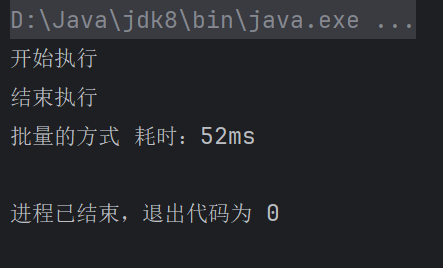
源码

连接池

传统获取Connection问题分析

数据库连接池基本介绍


连接放回去并不是关闭连接,而是不在引用这个连接(引用断开了,但连接对象还在)
数据库连接池种类
JDBC的数据库连接池使用javax.sql.DataSource来表示,DataSource只是一个接口,该接口通常由第三方提供实现
DBCP
DBCP数据库连接池,速度相对C3P0较快,但不稳定
C3P0
C3P0数据库连接池,速度相对较慢,稳定性不错(hibernate,spring)

方式1:相关参数,在程序中指定user,url,password等
// 创建一个数据源对象
ComboPooledDataSource comboPooledDataSource = new ComboPooledDataSource();
Properties properties = new Properties();
properties.load(new FileInputStream("src\\mysql.properties"));
String user = properties.getProperty("user");
String password = properties.getProperty("password");
String url = properties.getProperty("url");
String driver = properties.getProperty("driver");
// 给数据源设置相关的参数
// 注意,连接管理是由 comboPooledDataSource 来管理
comboPooledDataSource.setDriverClass(driver);
comboPooledDataSource.setJdbcUrl(url);
comboPooledDataSource.setUser(user);
comboPooledDataSource.setPassword(password);
// 设置初始化连接数
comboPooledDataSource.setInitialPoolSize(10);
// 最大连接数
comboPooledDataSource.setMaxPoolSize(50);
long start = System.currentTimeMillis();
for (int i = 0; i < 5000; i++) {
Connection connection = comboPooledDataSource.getConnection();
// System.out.println("连接成功");
connection.close();
}
long end = System.currentTimeMillis();
System.out.println("c3p0 5000次耗时" + (end - start) + "ms"); // c3p0 5000次耗时286ms
方式2:使用配置文件模版来完成
1.将c3p0提供的c3p0.config.xml拷贝到src目录下
2.该文件指定了连接数据库和连接池的相关参数
c3p0.config.xml
<?xml version="1.0" encoding="UTF-8"?>
<c3p0-config>
<default-config>
<!-- 这些是默认的连接池参数,如果没有在特定数据源中定义,则使用这些参数 -->
<property name="initialPoolSize">5</property>
<property name="minPoolSize">5</property>
<property name="maxPoolSize">20</property>
<property name="maxIdleTime">300</property> <!-- seconds -->
<property name="acquireIncrement">1</property>
<property name="maxStatements">50</property>
</default-config>
<!-- 数据源名称代表连接池 -->
<named-config name="myDataSource">
<!-- 特定于 myDataSource 的连接池参数 -->
<property name="driverClass">com.mysql.jdbc.Driver</property>
<property name="jdbcUrl">jdbc:mysql://localhost:3306/hsp_db02</property>
<property name="user">root</property>
<property name="password">hsp</property>
<!-- 初始的连接数 -->
<property name="initialPoolSize">10</property>
<property name="minPoolSize">5</property>
<property name="maxPoolSize">50</property>
<!-- 每次增长的连接数 -->
<property name="acquireIncrement">5</property>
<!-- 可连接的最多的命令对象数 -->
<property name="maxStatements">5</property>
<!-- 其他可选配置 -->
<!-- 每个连接对象可连接的最多的命令对象数 -->
<property name="maxStatementsPerConnection">2</property>
</named-config>
</c3p0-config>
ComboPooledDataSource comboPooledDataSource = new ComboPooledDataSource("myDataSource");
long start = System.currentTimeMillis();
for (int i = 0; i < 5000; i++) {
Connection connection = comboPooledDataSource.getConnection();
// System.out.println("连接成功");
connection.close();
}
long end = System.currentTimeMillis();
System.out.println("c3p0使用配置文件 连接/断开5000次 耗时:" + (end - start) + "ms"); // c3p0使用配置文件 连接/断开5000次 耗时:285ms
Proxool
Proxool数据库连接池,有监控连接池状态的功能,稳定性较C3P0差一点
BoneCP
BoneCP数据库连接池,速度快
Druid
Druid(德鲁伊)是阿里提供的数据库连接池,集DBCP、C3P0、Proxool优点于一身的数据库连接池
jar包下载地址:https://repo1.maven.org/maven2/com/alibaba/druid/1.1.10/
src/druid.properties
com.mysql.jdbc.Driver# Druid 配置文件模板 (druid.properties)
# 数据源配置
url=jdbc:mysql://localhost:3306/hsp_db02?rewriteBatchedStatements=true
username=root
password=hsp
driverClassName=com.mysql.jdbc.Driver
# 连接池参数配置
# 初始化大小
initialSize=10
# 最小空闲连接数
minIdle=5
# 最大连接数
maxActive=50
# 获取连接最大等待时间(毫秒)
maxWait=5000
Properties properties = new Properties();
properties.load(new FileInputStream("src\\druid.properties"));
// 创建一个指定参数的数据库连接池
DataSource dataSource = DruidDataSourceFactory.createDataSource(properties);
long start = System.currentTimeMillis();
for (int i = 0; i < 5000; i++) {
Connection connection = dataSource.getConnection();
// System.out.println(connection);
connection.close();
}
long end = System.currentTimeMillis();
System.out.println(end - start); // druid连接池 操作500000次 耗时330ms
Druid工具类
package com.hspedu.jdbc.datasource;
import com.alibaba.druid.pool.DruidDataSourceFactory;
import javax.sql.DataSource;
import java.io.FileInputStream;
import java.sql.Connection;
import java.sql.ResultSet;
import java.sql.SQLException;
import java.sql.Statement;
import java.util.Properties;
/**
* @program: chapter25
* @since: jdk1.8
* @description: 基于druid数据库连接池的工具类
* @author: Administrator
* @create: 2024-12-14 17:17
**/
public class JDBCUtilsByDruid {
private static DataSource ds;
static {
Properties properties = new Properties();
try {
properties.load(new FileInputStream("src\\druid.properties"));
ds = DruidDataSourceFactory.createDataSource(properties);
} catch (Exception e) {
throw new RuntimeException(e);
}
}
/**
* 获取数据库连接
*
* @return 返回数据库连接对象
* @throws SQLException 如果获取连接时发生SQL异常,则抛出此异常
*/
// 编写getConnection方法
public static Connection getConnection() throws SQLException {
return ds.getConnection();
}
/**
* 关闭数据库连接(把使用的Connection对象放回连接池)、声明和结果集
*
* @param rs 数据库结果集对象
* @param stmt 数据库声明对象
* @param conn 数据库连接对象
* @throws RuntimeException 当关闭过程中发生SQL异常时抛出
*/
public static void close(ResultSet rs, Statement stmt, Connection conn) {
try {
if (rs != null) {
rs.close();
}
if (stmt != null) {
stmt.close();
}
if (conn != null) {
conn.close(); // 对于Druid连接池,这里的close()实际上是归还连接到连接池
}
} catch (SQLException e) {
throw new RuntimeException("关闭数据库资源时发生异常: " + e.getMessage(), e);
}
}
}
使用工具类
@Test
public void testSelect() {
Connection connection = null;
String sql = "select * from actor where id = ?";
PreparedStatement preparedStatement = null;
ResultSet resultSet = null;
try {
connection = JDBCUtilsByDruid.getConnection();
preparedStatement = connection.prepareStatement(sql);
preparedStatement.setInt(1, 1);
resultSet = preparedStatement.executeQuery();
while (resultSet.next()) {
int id = resultSet.getInt("id");
String name = resultSet.getString("name");
String sex = resultSet.getString("sex");
Date borndate = resultSet.getDate("borndate");
String phone = resultSet.getString("phone");
System.out.println(id + "\t" + name + "\t" + sex + "\t" + borndate + "\t" + phone);
}
} catch (SQLException e) {
throw new RuntimeException(e);
} finally {
// 关闭资源
JDBCUtilsByDruid.close(resultSet, preparedStatement, connection);
}
}
APache-DBUtils
resultSet问题
1.关闭connection后,resultSet结果集无法使用
2.resultSet不利于数据的管理
3.示意图

原生解决方案
Javabean, POJO, Domain对象
package com.hspedu.jdbc.datasource;
import java.util.Date;
/**
* @program: chapter25
* @since: jdk1.8
* @description: Actor对象和actor表的记录对应
* @author: Administrator
* @create: 2024-12-14 19:21
**/
public class Actor {
private Integer id;
private String name;
private String sex;
private Date borndate;
private String phone;
public Actor() {
}
public Actor(Integer id, String name, String sex, Date borndate, String phone) {
this.id = id;
this.name = name;
this.sex = sex;
this.borndate = borndate;
this.phone = phone;
}
public Integer getId() {
return id;
}
public void setId(Integer id) {
this.id = id;
}
public String getName() {
return name;
}
public void setName(String name) {
this.name = name;
}
public String getSex() {
return sex;
}
public void setSex(String sex) {
this.sex = sex;
}
public Date getBorndate() {
return borndate;
}
public void setBorndate(Date borndate) {
this.borndate = borndate;
}
public String getPhone() {
return phone;
}
public void setPhone(String phone) {
this.phone = phone;
}
@Override
public String toString() {
return "Actor{" +
"id=" + id +
", name='" + name + '\'' +
", sex='" + sex + '\'' +
", borndate=" + borndate +
", phone='" + phone + '\'' +
'}';
}
}
把得到的resultset的记录,封装到Actor对象,放入到list集合
public ArrayList<Actor> testSelectToArrayList() {
Connection connection = null;
String sql = "select * from actor where id >= ?";
PreparedStatement preparedStatement = null;
ResultSet resultSet = null;
ArrayList<Actor> list = new ArrayList<>();
try {
connection = JDBCUtilsByDruid.getConnection();
preparedStatement = connection.prepareStatement(sql);
preparedStatement.setInt(1, 1);
resultSet = preparedStatement.executeQuery();
while (resultSet.next()) {
int id = resultSet.getInt("id");
String name = resultSet.getString("name");
String sex = resultSet.getString("sex");
Date borndate = resultSet.getDate("borndate");
String phone = resultSet.getString("phone");
// 把得到的resultset的记录,封装到Actor对象,放入到list集合
list.add(new Actor(id, name, sex, borndate, phone));
}
list.forEach(System.out::println);
} catch (SQLException e) {
throw new RuntimeException(e);
} finally {
// 关闭资源
JDBCUtilsByDruid.close(resultSet, preparedStatement, connection);
}
return list;
}
使用APache-DBUtils
基本介绍
1.commons-dbutils是Apache组织提供的一个开源JDBC工具类库,它是对JDBC的封装,使用dbutils能极大简化jdbc编码的工作量[真的]。
DbUtils:类
1.QueryRunner类:该类封装了SQL的执行,是线程安全的。可以实现增、删、改、查、批处理
2.使用QueryRunner类实现查询
3.ResultSetHandler接口:该接口用于处理java.sql.ResultSet,将数据按要求转换为另一种形
式,

使用DBUtils+数据连接池(德鲁伊)方式,完成对表的crud

public void testQueryMany() throws SQLException {
Connection connection = JDBCUtilsByDruid.getConnection();
QueryRunner queryRunner = new QueryRunner();
String sql = "select * from actor where id >= ?";
// query方法就是执行sqL语句,得到resultset--封装到-->ArrayList集合中
// new BeanListHandler<>(Actor.class):在将resultset->Actor对象->封装到ArrayList
// 底层使用反射机制去获取Actor类的属性,然后进行封装
// 1是给sql语句中的?赋值的
// 底层得到的resultset,会在query关闭,还会关闭PreparedStatment
List<Actor> list = queryRunner.query(
connection,
sql,
new BeanListHandler<Actor>(Actor.class),
1
);
for (Actor actor : list) {
System.out.println(actor);
}
JDBCUtilsByDruid.close(null,null, connection);
}
apache-dbutils+druid完成返回的结果是单行记录(单个对象)的处理
public void testQuerySingle() throws SQLException {
Connection connection = JDBCUtilsByDruid.getConnection();
QueryRunner queryRunner = new QueryRunner();
String sql = "select * from actor where id = ?";
// 因为我们返回的单行记录<--->单个对象,使用的Hander是BeanHandler
Actor actor = queryRunner.query(connection, sql, new BeanHandler<>(Actor.class), 1);
System.out.println(actor);
JDBCUtilsByDruid.close(null, null, connection);
}
演示apache-dbutils+druid完成查询结果是单行单列-返回的就是object
public void testScalar() throws SQLException {
Connection connection = JDBCUtilsByDruid.getConnection();
QueryRunner queryRunner = new QueryRunner();
String sql = "select name from actor where id = ?";
Object object = queryRunner.query(connection, sql, new ScalarHandler<>(), 1);
System.out.println(object);
JDBCUtilsByDruid.close(null, null, connection);
}
演示apache-dbutils+druid完成dml(update,insert,delete)
public void testDML() throws SQLException {
Connection connection = JDBCUtilsByDruid.getConnection();
QueryRunner queryRunner = new QueryRunner();
String sql = "update actor set name = ? where id = ?";
//(I)执行dml操作是queryRunner.update()
//(2)返回的值是受影响的行数
int affectedRow = queryRunner.update(connection, sql, "张三丰", 1);
System.out.println(affectedRow > 0 ? "成功" : "执行没有影响到表");
JDBCUtilsByDruid.close(null, null, connection);
}
表和JavaBean的类型映射关系

DAO增删改查-BasicDao
问题
apache-dbutils+Druid简化了JDBC开发,但还有不足:
1.SQL语句是固定,不能通过参数传入,通用性不好,需要进行改进,更方便执行增删改查
2.对于select操作,如果有返回值,返回类型不能固定,需要使用泛型
3.将来的表很多,业务需求复杂,不可能只靠一个Java类完成
4.引出=》BasicDAO画出示意图



基本说明
1.DAO:data access object数据访问对象
2.这样的通用类,称为BasicDao,是专门和数据库交互的,即完成对数据库(表)的crud操作。
3.在BaiscDao的基础上,实现一张表对应一个Dao,更好的完成功能,比如Customer表
Customer.java(javabean)-CustomerDao.java
BasicDAO应用实例

dao包
BasicDAO
package com.hspedu.dao_.dao;
import com.hspedu.jdbc.datasource.JDBCUtilsByDruid;
import org.apache.commons.dbutils.QueryRunner;
import org.apache.commons.dbutils.handlers.BeanHandler;
import org.apache.commons.dbutils.handlers.BeanListHandler;
import org.apache.commons.dbutils.handlers.ScalarHandler;
import java.sql.Connection;
import java.sql.SQLException;
import java.util.List;
/**
* @program: chapter25
* @since: jdk1.8
* @description: 开发BasicDAO,是其他DAO的父类
* @author: Administrator
* @create: 2024-12-15 15:12
**/
public class BasicDAO<T> { // 泛型指定具体类型
private QueryRunner qr = new QueryRunner();
/**
* 开发一个通用的DML(数据操作语言)方法,用于执行更新、插入或删除操作,适用于任意表。
*
* @param sql 要执行的SQL语句,通常为UPDATE、INSERT或DELETE语句。
* @param parameters SQL语句中的参数值,可变参数,允许传入多个参数。
* @return 返回受影响的行数,表示有多少行数据被更新、插入或删除。
* @throws RuntimeException 如果在执行SQL语句过程中发生SQL异常,则抛出此运行时异常。
*/
public int update(String sql, Object... parameters) {
Connection connection = null;
try {
connection = JDBCUtilsByDruid.getConnection();
int update = qr.update(connection, sql, parameters);
return update;
} catch (SQLException e) {
throw new RuntimeException(e);
} finally {
JDBCUtilsByDruid.close(null, null, connection);
}
}
/**
* 执行SQL查询并返回多个对象(即查询结果是多行),适用于任意表。
*
* @param sql 要执行的SQL查询语句。
* @param clazz 查询结果对象的目标类,必须是一个JavaBean类。
* @param parameters SQL查询中的参数值,可变参数,支持传入多个参数。
* @return 返回一个包含查询结果的列表,列表中的每个元素都是clazz类型的对象。
* 如果查询结果为空,则返回一个空列表。
* @throws RuntimeException 如果在查询过程中发生SQL异常,则抛出此运行时异常。
*/
// 返回多个对象(即查询的结果是多行),针对任意表
public List<T> queryMulti(String sql, Class<T> clazz, Object... parameters) {
Connection connection = null;
try {
connection = JDBCUtilsByDruid.getConnection();
List<T> list = qr.query(connection, sql, new BeanListHandler<T>(clazz), parameters);
return list;
} catch (SQLException e) {
throw new RuntimeException(e);
} finally {
JDBCUtilsByDruid.close(null, null, connection);
}
}
/**
* 执行SQL查询并返回单个结果对象
*
* @param sql 要执行的SQL查询语句
* @param clazz 结果对象的目标类,必须是一个JavaBean类
* @param parameters SQL查询中的参数值,可变参数,可以传入多个参数
* @return 查询到的单个结果对象,若查询结果为空则返回null
* @throws RuntimeException 如果在查询过程中发生SQL异常,则抛出此运行时异常
*/
public T querySingle(String sql, Class<T> clazz, Object... parameters) {
Connection connection = null;
try {
connection = JDBCUtilsByDruid.getConnection();
return qr.query(connection, sql, new BeanHandler<T>(clazz), parameters);
} catch (SQLException e) {
throw new RuntimeException(e);
} finally {
JDBCUtilsByDruid.close(null, null, connection);
}
}
/**
* 执行SQL查询并返回查询结果的第一行第一列的值。
*
* @param sql 要执行的SQL查询语句。
* @param parameters SQL查询中的参数值,可变参数,支持传入多个参数。
* @return 返回查询结果的第一行第一列的值,如果查询结果为空,则返回null。
* @throws RuntimeException 如果在查询过程中发生SQL异常,则抛出此运行时异常。
*/
public Object queryScalar(String sql, Object... parameters) {
Connection connection = null;
try {
connection = JDBCUtilsByDruid.getConnection();
return qr.query(connection, sql, new ScalarHandler<>(), parameters);
} catch (SQLException e) {
throw new RuntimeException(e);
} finally {
JDBCUtilsByDruid.close(null, null, connection);
}
}
}